Search Engine Optimisation (SEO) is one of the most important elements of Digital Marketing. It is dynamic – some of the principles have been around for a very long time but others change or new ones are added.
In this article I want bring up to speed on what I see as the key issues for 2018 to allow you to remain or gain a top position for your web. The birth of SEO can probably be identified with a very early interview on Charlie Rose by Sergy Brin and Larry Page
It had already changed radically when I started working on SEO 5 years later in 2006. Since then a lot has happened and while all the on page elements of technical SEO are still hyper important there are number of notable points, both on page and off page, that are going to affect SEO in 2018.
1. Mobile First
So Mobile First has been on the lips of SEO experts since November 2016. This is when Google first announced that they were experimenting with the notion, giving their rationale as:
“Today, most people are searching on Google using a mobile device. However, our ranking systems still typically look at the desktop version of a page’s content to evaluate its relevance to the user. ”
Makes sense doesn’t it.
However this caused a major upset in the community – with everyone scrabbling to fully understand the impact. Impact there certainly will be, but a lot of people initially expected it to happen in 2017. Here’s what Google’s Gary Illness said at the SMX Advanced Conference in June 2017:
“We don’t have a timeline for the launch yet,” he said. “We have some ideas for when this will launch, but it’s probably many quarters away. Our engineers’ timeline was initially end of 2017. Right now, we think more 2018. ”
So What Does Mobile First Mean For You?
The initial Google announcement made it quite clear that if you have a fully responsive website, (by the way check it against all the new retina displays) then there is not a great deal that needs to be done (however see all the other exceptions below). If on the other hand you have a different version of your website for mobile then you need to make sure that it is Search Engine Optimised.
They (actually Gary Illyes again) include in their latest blog (Getting your site ready for mobile-first indexing[1] Monday, December 18, 2017) a number of important elements that non-responsive webs need to optimise:
- high quality content including marked up images and videos (see below) – no surprise here
- structured data (see SERPs Feature below)
- meta data (so “aughts” but so important!)
- hreflang for internalization
- server capacity for increased crawling (of a separate web)
The blog entry says that they are already beginning to roll out the changes to a “handful” of sites but that they will be cautious when implementing on a wider scale. In fact Gary did say that they would communicate changes with webmasters (be prepared for a personal email – right, in your dreams!). Nonetheless getting everything ready before hand will save panicking to save those previously earned SERPs.
2. Speed
Speed has been a Google algorithm marker for many years. In fact in 2010 they already said that it was there. Google Analytics gives a huge emphasis (possibly even disproportionate) on the speed of websites and individual pages.
The reason is very simple. Bounce rate.
Google Analytics defines Bounce rate as:
“[…]a bounce is calculated specifically as a session that triggers only a single request to the Analytics server, such as when a user opens a single page on your site and then exits without triggering any other requests to the Analytics server during that session.”
So if you want visitors to your site to visit more than one page, then this is extremely important.
But this mania that Google has about fast loading pages goes much farther than this. They believe that most people won’t even wait for the page to load.
And you know what, they are probably right. Remember what it was like waiting for pages to load on a dial up connection (oops, maybe I am showing my age there) or even when Smartphones started to show web pages. The longer that you have to wait for a page to load the more likely you are to leave it, probably before it has already loaded.
In February of 2017 Google published the results of tests they had made that showed slower pages have a very negative effect on the bounce rate.
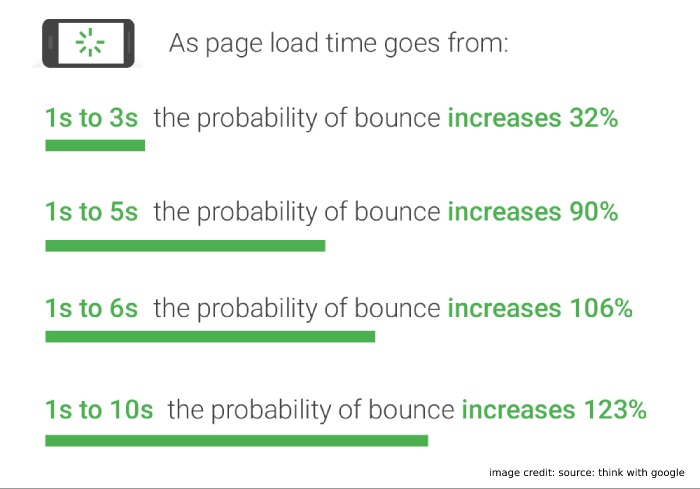
Google wants to show the best website for a specific search query – if visitors are likely to leave a webpage before it even loads, then clearly it is not the best page to show and therefore should be lower down in the SERPs.
In the case of very slow sites (and remember they are going to be looking at them in mobile conditions) then it may also limit the number of your pages that they will crawl and therefore index:
“[If] We’re seeing an extremely high response-time for requests made to your site (at times, over 2 seconds to fetch a single URL). This has resulted in us severely limiting the number of URLs we’ll crawl from your site.” John Mueller, Google
There are very many ways of making your website load faster and Google has a couple of tools that can show you where to begin:
- for mobile sites click here
- for regular (and mobile) sites click here
No section on speed can skip the importance of the Google and Twitter led initiative of AMP. The Accelerated Mobile Pages Project refers to the open-source initiative to make the mobile web better for all by building a performance-focused ecosystem comprising of publishers and technology providers.
Google shows AMP websites with a special icon and I would hazard a guess that these sites are going to rank well when the Mobile First initiative is fully implemented.
Now to use AMP you will need to have an alternative website although there are plugins for common platforms such as WordPress. So with our own web there are now two versions
3. SERPS Features
There was a time when you saw just some AdWords on the top of the page and right hand side and Organic results as the main dish.
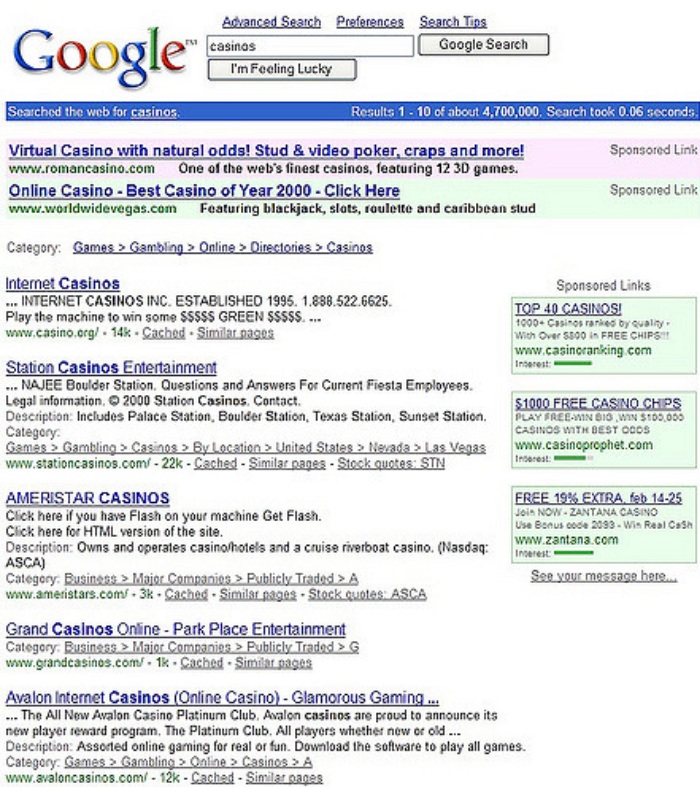
but that has now completely changed:
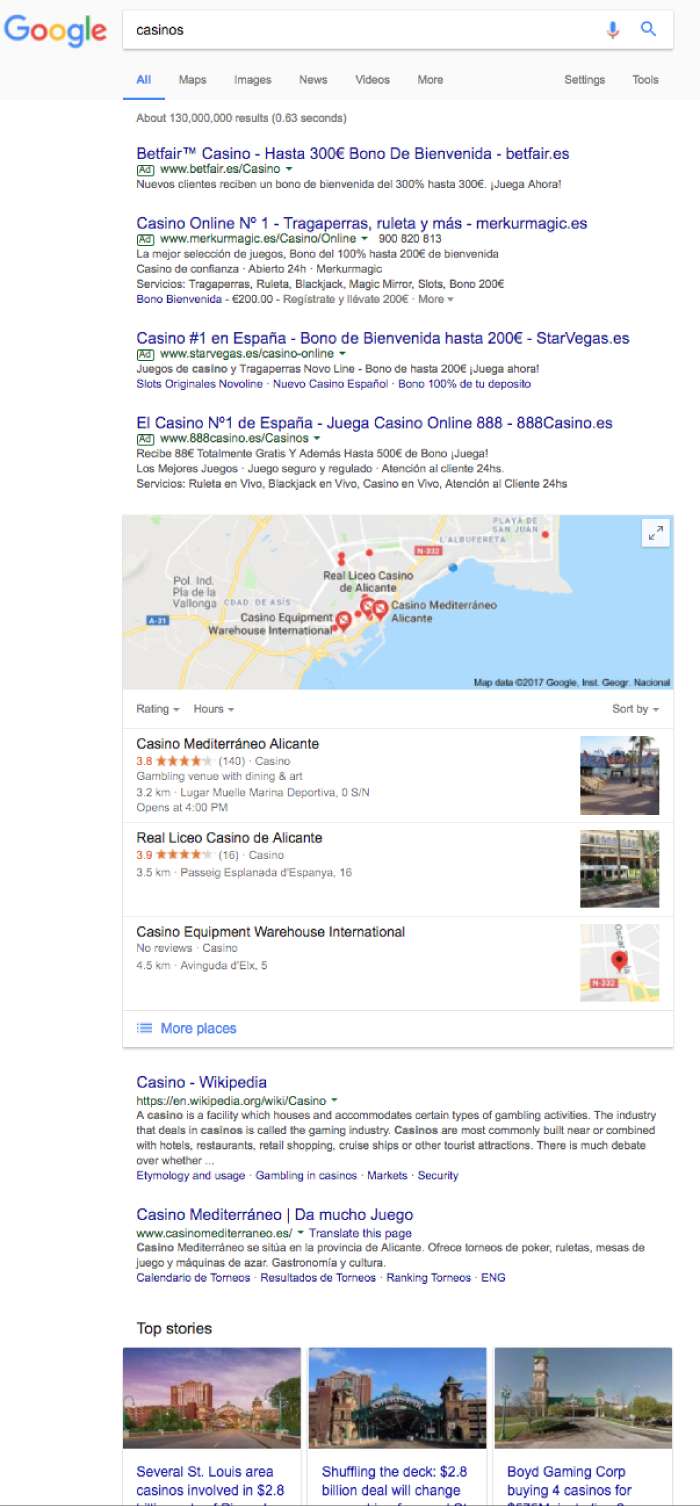
There are now so many different elements on a page that standard organic results are difficult to see and are visually less attractive then other elements. Some of these elements you can affect directly and others not. Here is what you can find that you can influence to getter better visibility in the SERPs:
Featured Snippets
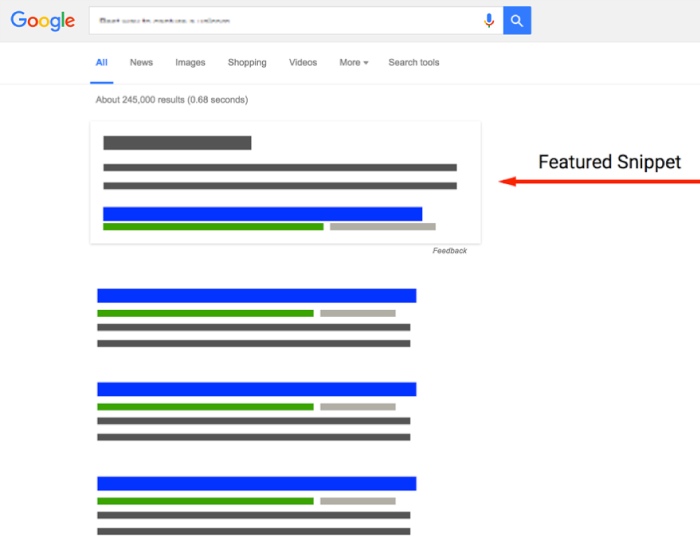
Google describes this as
…a snippet extracted programmatically from what a visitor sees on your web page. What’s different with a featured snippet is that it is enhanced to draw user attention on the results page. When we recognize that a query asks a question, we programmatically detect pages that answer the user’s question, and display a top result as a featured snippet in the search results.”
There are 3 types of featured snippets:
- Paragraph (the answer is given as text). It can be a box with text inside or a box with both text and an image inside.
- List (the answer is given in a form of a list)
- Table (the answer is given in a table)
Getting a page into a Featured Snippet gives you a distinct advantage over the other results other results. Here’s the results from a page on one our clients webs. In about April of 2016 we suddenly noticed that there was a snippet for it:

Subsequently the traffic to this blog entry leaped up and has remained high ever since.

In particular we have noticed that there are many more backlinks to this page as it is being referenced by other webs.
Clearly one of the ways of attaining a snippet is to shortly and succinctly answer a question. Logically the question needs to be related and coherent to the rest of the web content.
Related questions are also now becoming more common and essentially are further entries similar to the main featured snippet.

The same rules apply about getting visibility here.
Local Content
Local content will show for almost any search that has anything remotely to do with a product or service. Basically for these types of searches the results are tailored to the person making the search.

As I was looking for casinos from our Alicante (Spain) office the results are showing me the local gambling joints in Alicante!
Making sure your business is in Google My Business will ensure that you end up in these results.
Videos

Having a YouTube video embedded in your page is going to give you the possibility to get an entry in the listing of organic results with a video in it. Obviously you need to ensure that the Rich Snippet for the video is correctly placed. In our experience the main item in the page needs to be the video for this to happen. Having a page with a video half way down a 1,000 word article probably won’t get you the snippet.
Sitelinks
Sitelinks are extensions of your site:
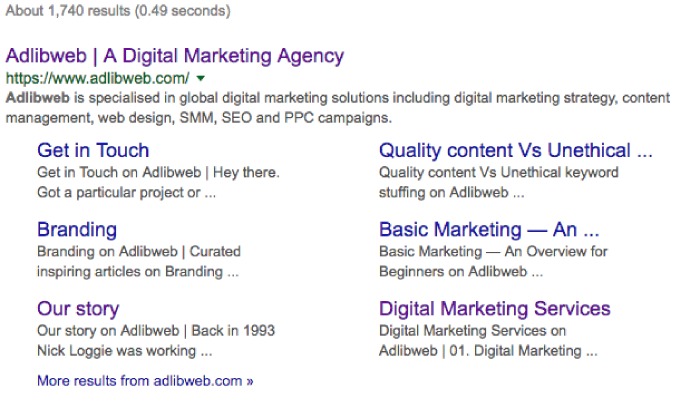
The purpose of Sitelinks is to help users navigate around your website. A user searching for “Blogging Wizard” might not necessarily want to see the homepage. Instead, they might be interested in heading directly to the blog page or the about page.
Sitelinks remove one step from this navigation process by placing important links right within the search results.
“We only show Sitelinks for results when we think they’ll be *useful to the user*. If the structure of your site doesn’t allow our algorithms to find good Sitelinks, or we don’t think that the Sitelinks for your site are relevant for the user’s query, we won’t show them.”
There is no direct way to get Sitelinks for your website. You can’t just log into Google’s Search Console[2] (Previously Webmaster Tools), flick a switch and get Sitelinks.
Currently:
- Sitelinks are automated
- Sitelinks are created through website best practices
- Google doesn’t give you any advice about how to obtain sitselinks.
They do however give quite an advantage. The Click through Rate (CTR) increases on average by about 50%, you get better brand awareness (as you take up more space on the page), they give visibility to a layer of navigation beyond the homepage and they build more trust.
There are a number of ways you can try and get Google to trigger sitelinks:
- Abrand name as opposed to a generic search term
- Make sure that Google can easily navigate your web structure
- Include a sitemap that Google can use to navigate
- Rank number one for your brand name
Images
Images are often overlooked and webmasters forget to index their images. In the case of a blog this can be a very useful way of getting traffic.

If you have great photos for a generic product then this can also be a great way of getting one over the competition.
Knowledge Box
The knowledge box can be shown for a generic item giving key information but can equally be given for a company – your company. It is a great way to get your address, telephone number in front of an audience.

Again ensuring that your Google My Business details are correct will allow you to get the set of results that show all the key elements of your business including operating hours and any events that you may be having.
4. Rank Brain
RankBrain sounds like some sort of artificial intelligence form A Stanley Kubrick movie. Guess what – it is an Artificial Intelligence bot – that works out ranking.
“RankBrain uses artificial intelligence to embed vast amounts of written language into mathematical entities – called vectors – that the computer can understand. If RankBrain sees a word or phrase it isn’t familiar with, the machine can make a guess as to what words or phrases might have a similar meaning and filter the result accordingly, making it more effective at handling never-before-seen search queries.”
Basically RankBrain (as far as can be determined) looks at two factors:
- How long a visitor stays on your page (Dwell Time)
- How many people click on your result in the SERPs (Click Through Rate)
The same Gary Illyes from Google has said that webmasters can optimise for RankBrain using natural language.
“Optimizing for RankBrain is actually super easy, and it is something we’ve probably been saying for fifteen years now, is – and the recommendation is – to write in natural language. Try to write content that sounds human. If you try to write like a machine then RankBrain will just get confused and probably just pushes you back.
But if you have a content site, try to read out some of your articles or whatever you wrote, and ask people whether it sounds natural. If it sounds conversational, if it sounds like natural language that we would use in your day to day life, then sure, you are optimized for RankBrain. If it doesn’t, then you are “un-optimized”.
Obviously if you have a long and interesting content page then the dwell time on the page will be longer. Similarly if you have a video that is interesting then the time on the page will be longer.
In terms of CTR it is also obvious – you need to have the extract of your page totally correct so those Metatags that you thought had disappeared really do make a difference. Here’s what Google says:
“The description attribute within the tag is a good way to provide a concise, human-readable summary of each page’s content. Google will sometimes use the meta description of a page in search results snippets, if we think it gives users a more accurate description than would be possible purely from the on-page content. Accurate meta descriptions can help improve your clickthrough; here are some guidelines for properly using the meta description.”
Again Google is going to promote a website that has a high click through rate especially when the dwell time on the page is high as well.
5. In Depth Content
As we have seen one of the keys to RankBrain is the dwell time on the page. Part of that formula is to have in depth content.
Way back in 2013 Google signalled this as a key point. Pandu Nayak said:
“I’m happy to see people continue to invest in thoughtful in-depth content that will remain relevant for months or even years after publication. ……. In addition to well-known publishers, you’ll also find some great articles from lesser-known publications and blogs.”
Length will help get you there, think minimum 2,000 words, but it is not everything. The content needs to be clear and coherent with the rest of the website. This means that Google can relate the article to the rest of the site. Internal linking will help.
Basically the idea is to write an article that actually shows that you know what you are talking about. It will also mean that others will link to it and boost the ranking in the SERPs.
The style can vary but you should make it easy to read. One of the essential elements is to break up the text into short paragraphs and use plenty of diagrams, illustrations, graphs and images (where appropriate).
Neil Patel is particularly good at this – you would do well to take a leaf out of his book (er, blog).
The term authority is used in terms of the article. Essentially the number of inbound links to the page and the domain is a measure of the authority. The higher the authority the better the signal to Google to rank the page high.
Another marker for Google is the number of time the article has been shared on Social Media. It is therefore essential to make it easy for the reader to share. If we are talking about a long article the sharing buttons need to be visible when the reader arrives at the epiphany that they want to share it. Floating share buttons can be very useful.
6. Latent Semantic Index Keywords
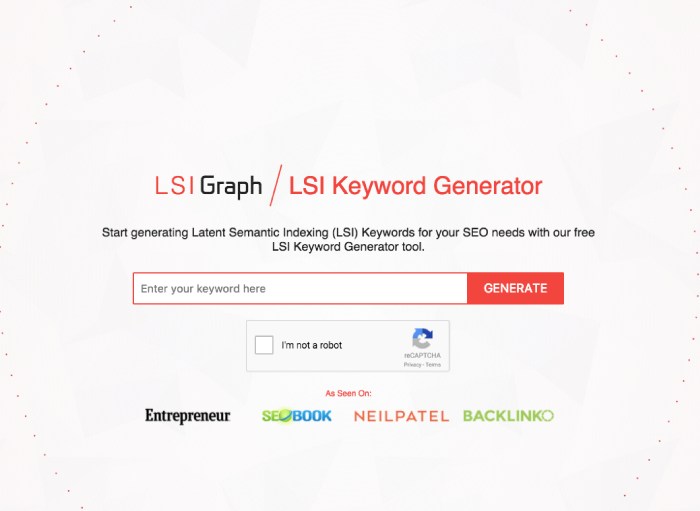
Latent Semantic Index Keywords (LSI) are phrases that are related to the article’s main keyword. They are a group of synonyms and related phrases that Google could expect to see within the board context of the article.
If you are writing about meditation for example then Google might expect to see words like calm, stress, Zen, monk, etc.
LSI Keywords Are Important To Google
Back in the day Meta Tag keywords gave Google an opportunity to put the article into context. Those days are long gone and Google has got smarter. The LSI keywords in the text, help Google figure out what your article is all about.
Taking our mediation example words such as Zen, Buddhism might suggestion as spiritual or religious bent to the article, while words like Mindfulness might suggest a more healing or self help approach.
LSIs let Google define the specific area within a broader subject. Not having the associated keywords could hinder your SEO results. Making sure you hit the key LSIs will be beneficial.
Choosing The Right LSI Keywords
Personally I use two tools to choose the LSIs for an article. The first is really simple to use and is available to everyone and I bet you have already used it. Google.
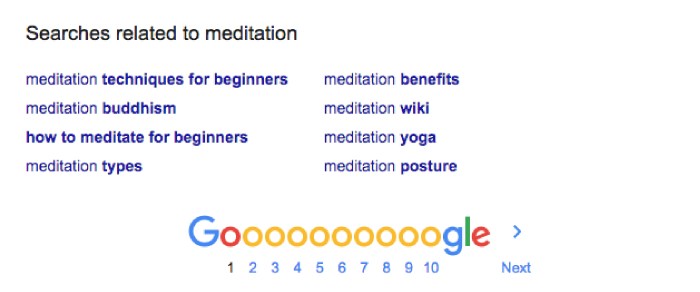
You know when you search for a term and at the bottom of the search Google shows you term associated with your main search. Those are the LSI keywords. Some of them will be going in the specific direction of your article and others may be going off in another. Make a note of the ones that are related to your article and click. Once again note the related searches below. You can continue as much as you want but a couple of layers would be the norm for an in depth article.
There is also a specific search engine as well which can add some extra depth namely LSI Graph [3] . A majority of SEO experts refer to this LSI tool as the best Google SEO keyword generator.
Like other tools in use for SEO you need to use them with care and consideration. Like blindly sending out linking outreach emails to 10,000 sites your success will be limited if you do not think about the context of the keywords.
7. SSL

SSL (Secure Socket Layer) technology results in the use of “https” for your site as opposed to “http”. Chrome and Firefox indicate a secure status with a green locked padlock. If you manage a number of sites you will almost certainly have received an email from Google suggesting that your site use https. Google themselves say:
*”HTTPS (Hypertext Transfer Protocol Secure) is an internet communication protocol that protects the integrity and confidentiality of data between the user’s computer and the site. Users expect a secure and private online experience when using a website. We encourage you to adopt HTTPS in order to protect your users’ connections to your website, regardless of the content on the site.”
The results have been confirmed quite conclusively that having https for your website is a pre-requisite for a place in the first page. In April 2017 Rank Ranger found that 98% of first page results contained at least 1 https results.
From 1st May 2016 to 20th April 2017 the number of results on the 1st page that were https jumped from an average of 2.6 results to 4.5 during the same period translating to a 75% yearly increase. 4.5 is very close to the 50% of the results having https.
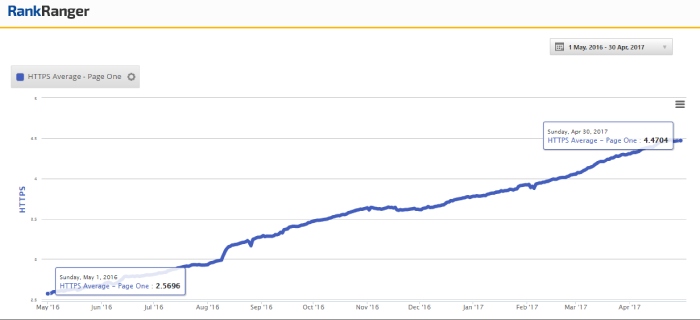
Indecently Moz also showed that in April of 2017, 50% of all first page results were https and extrapolating they went on to predict that at beginning of 2018 it will be close to 70%. If you don’t have https implemented already then make sure you get it done fast.
A Word Of Warning
Early in 2017 Google expressed some doubt as to the way in which some providers, specifically Symantec, issued SSL certificates, and effective of March 2018, Chrome will stop recognising Symantec’s Extended Validation certificates.
As Google doesn’t trust Symantec’s procedures, Chrome will recognise that the site has a certificate, but won’t treat it as Extended Validation.
Subsequently Symantec sold its certificate authority (CA) business to DigiCert for US$950 million (a nice little earner) and a 30-percent stake in the company, leaving DigiCert to sort out the problem.
Make sure your SSL certificate comes from a recognised and approved authority.
8. Video
Video on the Internet just get bigger and bigger. Cisco, in their the Visual Network Index[4], a 12-year-long project that brings together several independent analyst forecasts with network usage data Cisco gathered from its customers and its own servers, predict that by 2021, 82% of all consumer IP traffic will be video.
The growth will be generated by a massive leap in live streaming, coming from sites like Facebook, YouTube and Twitter. However traditional video or recorded streams will also make a large impact.
This popularity makes it easy for your “readers” to consume your content. People are used to looking at video. After all we have all been brought up on the visual experience with TV – it is natural.
By having the video first in the page might also allow you to achieve the Featured Video element in the search results. Make the video visually exciting and it will also increase the dwell time on the page – increasing your chances with Rank Brain.
By transcribing the content of the video onto the page your will also allow Google to pick up on the specific keywords and LSI keywords.
It is extremely easy to embed video into your articles. Using video content made by others may be suitable for some and let’s face it, there are endless possibilities. Furthermore making your video is not difficult nor expensive and can be used to make an article more personal.
One quick take away: If you upload your own video then you will have some important opportunities to link to the page or site – and remember that Google owns Youtube.
9. Embeddable Visual Content
Having images in an article is a given. You need them to explain and also break up the text. However you can also make them work at a different level and get them to help your SEO results.
This takes us back a couple of years to when every other page was a infographic and we all became totally saturated with hipster images of how many widgets were bought online worldwide.
However the underlying theory was correct – getting people to link back to your site using your image did make a difference – they were and still are inbound links. Giving the user a way to copy the code makes it easier for them to share and should be encouraged.
However don’t expect a huge uptake of the image unless you really do have some interesting data in the form of a graphic or a truly original and good looking image.
Google Image Search
The other thing to remember with images is that Google has a whole tab dedicated to images. But do people still use it? Jumpshot [5], big data and marketing analytics platform, using data in the order of millions of searchers, see that about a third of all the searches performed on Google are performed in Google Image Search.
That is a very large number! A very large number indeed and an equal opportunity for organic traffic.
The problem is that now Google simply shows your image with a link to it and to your website. So if the image in itself is enough to answer the search query, no-one is ever going to open up your website. However there is a link so under some circumstances the search query will mean that the person will click through to your site.
So what types of images do well?
- Visually sold products and services
- Images designed to earn links and citations such as Infographics
- Visual content licensers such as Getty Images
How To Rank With Images
There are a number of parameters that you need to get right for your images to rank well:
- The image file name – make it search engine friendly not img1.jpg but kitchen-worktop-in-chicago.jpg
- The alt attribute on the image– for accessibility as well as SEO
- The image caption – this is a differentiator for image search. Make sure you have one to rank well. This is also of course very human friendly as well, in the actual page itself.
- Coherence of text – that is close to the image. This will help build relevance.
- The page title – should be semantically relevant to the image
- The page URL – semantically relevant
- Image engagement and popularity – just like RankBrain images will also be pushed up the ranking if they have a high CTR. If your image has been embedded on other sites then the ranking will be higher
- The image dimensions matter – having the ratio of images to be within normal lists is a good idea so 16:9 or 4:3 or 1:1 will rank better than other ratios
- Image size – make sure that your images are a reasonable size. Apart form icon, most images that are shown are greater than 300 x 400 px
10. Voice Search
So voice search may seem to be a long shot but in fact is already here. “40% of adults now use voice search once per day” according to Location World [6] and looking to future “50% of all searches will be voice searches by 2020” according to comscore [7] and “This year (2017), 25 million devices will be shipped, bringing the total number of voice-first devices to 33 million in circulation.” based on a new study by VoiceLabs [8] via Mediapost [9].
So in summary 40% use it now it is going to grow by 25% in the next 2 years and the driver is voice-first devices.

This is the key to voice search – Alexa, Echo and Google Assistant as well as Siri and Cortana. The uptake of the Home Voice First devices is already massive and that will continue to drive usage of voice search inside and outside of the home or office environment. “41% of people using voice search have only started in the last 6 months” according to MindMeld [10] – so this is no longer in the early adopter stage.
So What Happens With Voice Search – Why Is It Different?
Google Home will cite the source of the information by saying the website’s name[11], and it will often send a link to the searcher’s Google Home app. Google Home and Google Assistant read snippets from results have the featured snippet spoken of earlier. Yet another reason to make sure that your site gets those all important Featured Snippets.
Voice search queries focus on action trigger words such as “who,” “what,” “where,” “when,” “why” and “how.” According to Google’s Mariya Moeva [12], voice searches on Google are 30 times more likely than text searches to be action queries.
Voice searches tend to be much more locally oriented. As a result they use words that are more natural when searching. So words like “close” or “nearby,” will be used instead of “in” or “at”. “Tell me about good Italian restaurants serving Tiramisu close to where I am now.” would be a reasonable voice search.
They are also going to much longer. We have seen a massive leap in the number of words used in searches. Google Analytics allows you to look at the number of words used that trigger a key word in AdWords. For one our clients in the tech sector this meant that over 15% of the terms used to search for their site were more that 10 words long.
The key to success then is use many latent semantic index keywords and phrases. Writing in a conversational fashion could help, but this is not always achievable in, for example, a product description. However in comments or in blog articles it can sometimes be written into the copy.
Read More: 5 Powerful SEO Hacks That Will Rank You Higher In Search Engines
11. Links
Every year SEO professionals ask the question “Is Linking Building dead for SEO”. I am sure that there is an element of sheer hope built into this question. Link building is a very very boring part of SEO. Unfortunately in 2018 it has still not had a cardiac arrest and stopped being a part of the equation.
Linking is still a very strong signal for Google – some say the strongest. Here is a summary of the key points you need to have in your link building strategy:
- domain diversity is important. In other words, it’s better to get 20 links from 20 different sites than 20 links from the same domain.
- overall link authority (measured using Ahrefs Domain Rating[13]) is strongly tied to Google rankings. This means that quality links from higher authority sites that have content that is relevant and coherent are extremely important
- repetitive links will cheapen the values of the links and might even hurt you if there are too many – this refers to signatures, bios, comments or other items used on multiple websites
- use of repetitive anchor texts – if a webmaster links to your site with exactly the same anchor text then you will see diminishing returns. Don’t prescribe anchor texts is the message
- you don’t need to have 100% do-follow links. Some no-follow links is natural and there is growing evidence to suggest that they are necessary for good ranking
- internal linking is still an important marker to Google– it shows them what is important to you in your website.
Conclusion
This coming year is going to be no different for SEO to last ten. There will be change to the SEO environment! The Google algorithm changes and SEO practices need to change to be in line with it.
In this article I have tried to outline what we see as the major changes that webmaster need to take into account to keep pace with the changes.
Feature Image Credit: Shutterstock.com
In Post Image Credit: Provided By Author




